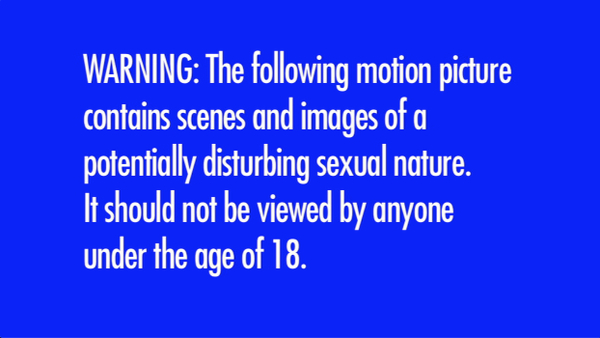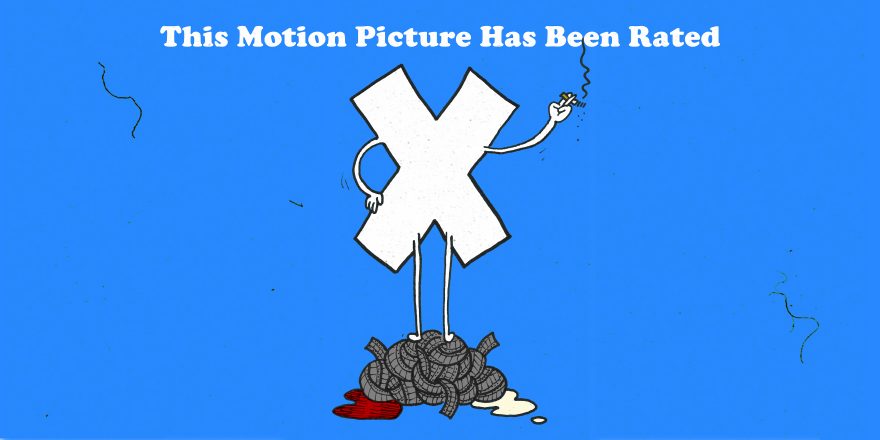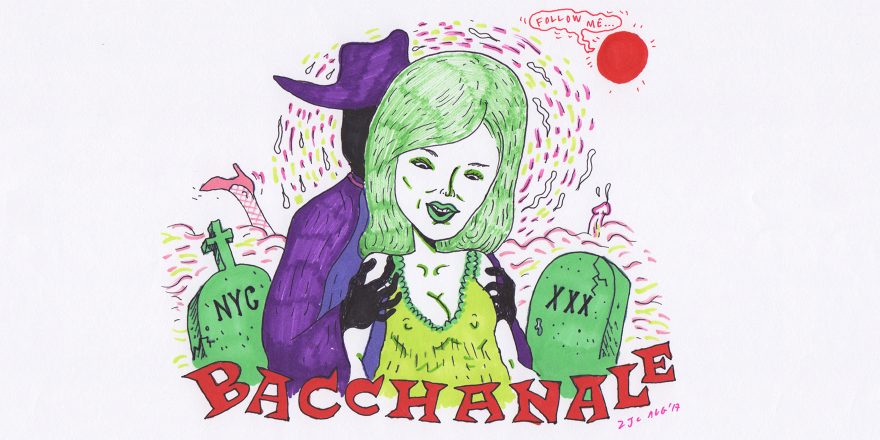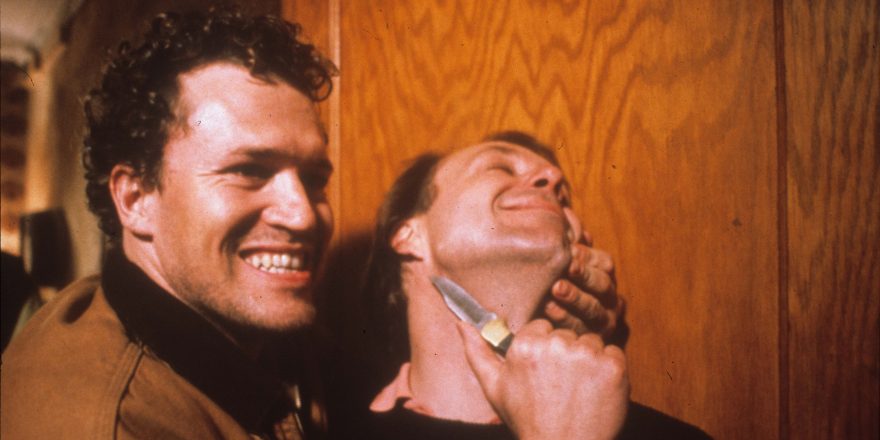It was a childhood dream of mine to make an X-rated movie. I would peruse the newspapers, looking at the lineups for Washington, D.C.’s two art house theaters, the Key and the Biograph. In addition to the hoity-toitier cineaste fare, both theaters (but the Biograph especially) kept the lights on by also screening more salacious titles, ranging from midnight classics both past and present, such as Pink Flamingos, Score and Meet the Feebles, to straightforward hardcore pornography. The fact that I never actually saw a movie at either theater (the Biograph closed in 1996, when I was 14, and the Key shuttered one year later) only built up their mystique, and their regular roster of X-rated titles made them feel like forbidden places.
Although the X rating itself was buried in 1990 and replaced with NC-17, when I landed a job at Alexandria, Virginia’s Video Vault in high school, it was one of the store’s points of pride to carry a large selection of titles whose lurid VHS boxes brandished the scarlet letter. Now I had access to the unknown pleasures I was unable to experience at the movie houses – Flesh for Frankenstein, Fritz the Cat, La Grande Bouffe, and more, more, more. There was no surer mark of quality than that little encircled cross. An “X” serves as a warning, in a way that “NC-17” never will – the letter’s very structure says “go no further” and, like a stamp for “Grade F” meat, guarantees that the contents of its package will be bad for you. To steal the tagline from a personal X-rated favorite, “Bad is good, but it’s not nice!”
After graduating film school, I was dying to make a feature and hot to misbehave. I wrote an exploitation melodrama about a disenchanted dominatrix, shot it on weekends for six months for $20,000, and passed it off as an indie movie on the regional film festival circuit. In was 2009, and almost anything was possible. Had I been given the opportunity to self impose an X-rating, I would’ve taken it, but instead I chose to open the movie with this image:

Whether or not the content in Modern Love is Automatic actually warranted this disclaimer was beside the point. I wanted to set up a roadblock between the audience and the movie: “Abandon all taste, ye who enter here.”
And now it is almost a decade later, and the Quad Cinema, responsible for some of New York City’s most outré repertory programming (their 35 mm screening of the bonkers Liz Taylor plastic-surgery melodrama Ash Wednesday was one of this year’s wildest rediscoveries) is putting on a retrospective of films that bore the blessed “X” and proved this stigma was actually a mark of quality. Virtually every genre is represented here, but it’s more surprising to see the range of budget levels and remember that there was a time, both inside Hollywood and out, when producers were not afraid to make adult entertainment for adults, and that audiences responded in turn.
There are too many masterpieces on display in the Quad’s expansive series to single out a shining star, and much has been written eloquently and at length about the cultural and aesthetic significance of these guiltiest of pleasures. What follows is a cursory overview of some of my personal highlights. In the event that you don’t have the luxury to see all of these, like it when other people make decisions for you, or are just feeling itchy after a long day at work, treat this like a pocket guide to motion picture history’s most notable miscreants:
Beyond the Valley of the Dolls (Russ Meyer, 1970) Not much more can be said about this movie other than that it is one of the best that has ever been made.
De Sade (Cy Endfield and an uncredited Roger Corman, 1969) American International Pictures’ foray into X territory mixes the tone, pace and production value of Corman’s Edgar Allan Poe adaptations with tame-by-today’s-standards scenes of Sadean excess. When the lusty Marquis gets hot under the collar, the scenes are bathed in blood-red light. De Sade approaches the line between art and trash, but smartly sticks to the trashy side.
Female Trouble and Desperate Living (John Waters, 1974 and 1977) If Western Civilization as we know it is ending, at least John Waters’ movies seem to be screening in New York on a semi-monthly basis.
The Evil Dead (Sam Raimi, 1981) Horror cinema at its most corporeal and the definition of a “riot.”
Fritz the Cat (Ralph Bakshi, 1972) I hadn’t seen this one in ages until revisiting it this past week. I think R. Crumb is right to hate it, and it’s a far cry from Bakshi’s best, especially considering that he’d go on to tackle the same territory in the undisputed classics Heavy Traffic and Coonskin. Fritz is still worth watching as both a time capsule and an early example of Bakshi’s bouncy brutalism.
Henry: Portrait of a Serial Killer (John McNaughton, 1986) I was once told that G. G. Allin kept the poster for this movie featuring the banned Joe Coleman artwork folded in the back pocket of his jeans at all times, like a hanky code for psychopaths. If that doesn’t get butts in the seats, I don’t know what will.
I Drink Your Blood (David Durston, 1970) If you haven’t seen this Manson-lite LSD hippy cult vs. rabid construction worker zombies opus, turn your brain off and go-go-go. Dumb fun is rarely this dumb or this fun.
In the Realm of the Senses (Nagisa Oshima, 1976) Erotic cinema at its most corporeal. In setting out to create a work of true pornography, Oshima doesn’t present a single image that feels excessive or unnecessary.
Inga (Joseph W. Sarno, 1968) Sarno has already established himself as the Bergman of 42nd Street when he was producing cheapie smut melodramas in the ’60s. It was only natural he would migrate to Sweden, where his movies only got hotter and sadder. Inga isn’t his masterpiece, but it’s a classic of exploitation cinema nonetheless, and any opportunity to watch a Sarno picture on the big screen is a rare treat.
La Grande Bouffe (Marco Ferreri, 1973) What if the Food Network remade Pier Paolo Pasolini’s Salo, or The 120 Days of Sodom? I’ve seen this movie maybe three to five times in my life, and by the end of its more than two-hour running time, the cumulative effect of the debaucheries displayed never fails to pack a revolting punch. Perfect viewing for anyone who needs another reason to eat a little less this holiday season.
Salon Kitty (Tinto Brass, 1976) A true sleaze epic, gorgeously designed and shockingly explicit. Starring art cinema’s go-to hot Nazi Helmut Berger!
The Texas Chain Saw Massacre and The Texas Chainsaw Massacre 2 (Tobe Hooper, 1974 and 1986) Hooper’s directorial oeuvre was spotty to say the least, but considering he directed one of the best horror movies of all time and then delivered one of the best horror satires of all time with its sequel, then I guess the rest doesn’t really matter. Few films are as unshakeable as the original Chain Saw, which manages to get more terrifying with each subsequent viewing. The follow-up, with its pop soundtrack and crosshairs on consumerism, is as iconic an ’80s picture as any of the standard-issue dreck from John Hughes, whose Breakfast Club poster was hilariously subverted in this film’s marketing campaign.
Tie Me Up! Tie Me Down! (Pedro Almodóvar, 1989) I still love Matador the most, but kinky Almodóvar is the best Almodóvar.
Women in Revolt (Paul Morrissey, 1971) Too rarely screened and seldom discussed, Women is overshadowed by Morrissey’s Joe Dallesandro trilogy Flesh, Heat and Trash and his Euro-horror outings with Udo Kier. That’s a shame because it might be the best of the bunch, and for my money is a contender for Funniest Movie of All Time. Candy Darling, Jackie Curtis and Holly Woodlawn give career-defining performances, screeching and snarling their way through the wittiest dialogue this side of a screwball comedy. You’ll laugh! You’ll cry because you’ve been laughing so much! You’ll watch a man wearing panties almost have his penis catch on fire!
In its time, the X rating had the added bonus that you actually had to go to the theater to see what Jack Valenti didn’t want you to. Now, pretty much anyone can get their hands on pretty much anything with a couple clicks of a mouse and few, uh, strokes on a keyboard. It’s worth noting that there are a couple recent examples of distributors trying to recapture the effect of the X rating in spirit, if not in letter. IFC Midnight recently did a one-day-only screening of the director’s cut of Lars von Trier’s “controversial” serial-killer movie The House That Jack Built, which promised gruesome thrills that you wouldn’t get from the theatrical release, and the stunt appeared to pay off, with screenings sold out left and right across New York. Netflix, with their false mantra of “watch whatever you want, whenever want,” has recently posted a horror-anthology show called Don’t Watch This. Cool, Netflix, thanks for saving me the time!
This holiday season, I’m thankful the Quad is giving New York’s moviegoers a chance to return to the theater and indulge humanity’s collective desire to vicariously transgress. It’s cold outside and it’s getting colder, and what better way to stay warm than sitting in a dark theater with a bunch of strangers, watching dangerous art and being bad together.
Original art by Zach Clark







